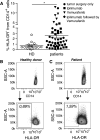Frequencies of circulating MDSC correlate with clinical outcome of melanoma patients treated with ipilimumab
- PMID: 24357148
- PMCID: PMC11029062
- DOI: 10.1007/s00262-013-1508-5
Frequencies of circulating MDSC correlate with clinical outcome of melanoma patients treated with ipilimumab
Abstract
Metastatic melanoma has a poor prognosis with high resistance to chemotherapy and radiation. Recently, the anti-CTLA-4 antibody ipilimumab has demonstrated clinical efficacy, being the first agent to significantly prolong the overall survival of inoperable stage III/IV melanoma patients. A major aim of patient immune monitoring is the identification of biomarkers that predict clinical outcome. We studied circulating myeloid-derived suppressor cells (MDSC) in ipilimumab-treated patients to detect alterations in the myeloid cell compartment and possible correlations with clinical outcome. Lin(-) CD14(+) HLA-DR(-) monocytic MDSC were enriched in peripheral blood of melanoma patients compared to healthy donors (HD). Tumor resection did not significantly alter MDSC frequencies. During ipilimumab treatment, MDSC frequencies did not change significantly compared to baseline levels. We observed high inter-patient differences. MDSC frequencies in ipilimumab-treated patients were independent of baseline serum lactate dehydrogenase levels but tended to increase in patients with severe metastatic disease (M1c) compared to patients with metastases in skin or lymph nodes only (M1a), who had frequencies comparable to HD. Interestingly, clinical responders to ipilimumab therapy showed significantly less lin(-) CD14(+) HLA-DR(-) cells as compared to non-responders. The data suggest that the frequency of monocytic MDSC may be used as predictive marker of response, as low frequencies identify patients more likely benefitting from ipilimumab treatment. Prospective clinical trials assessing MDSC frequencies as potential biomarkers are warranted to validate these observations.
Conflict of interest statement
The authors declare no conflict of interest.
Figures




Similar articles
-
Clinical Significance of Circulating CD33+CD11b+HLA-DR- Myeloid Cells in Patients with Stage IV Melanoma Treated with Ipilimumab.Clin Cancer Res. 2016 Dec 1;22(23):5661-5672. doi: 10.1158/1078-0432.CCR-15-3104. Epub 2016 May 13. Clin Cancer Res. 2016. PMID: 27178742
-
Baseline Peripheral Blood Biomarkers Associated with Clinical Outcome of Advanced Melanoma Patients Treated with Ipilimumab.Clin Cancer Res. 2016 Jun 15;22(12):2908-18. doi: 10.1158/1078-0432.CCR-15-2412. Epub 2016 Jan 19. Clin Cancer Res. 2016. PMID: 26787752 Free PMC article.
-
Ipilimumab-dependent cell-mediated cytotoxicity of regulatory T cells ex vivo by nonclassical monocytes in melanoma patients.Proc Natl Acad Sci U S A. 2015 May 12;112(19):6140-5. doi: 10.1073/pnas.1417320112. Epub 2015 Apr 27. Proc Natl Acad Sci U S A. 2015. PMID: 25918390 Free PMC article.
-
Adjuvant therapy for resected stage III melanoma patients: high-dose interferon-alpha versus ipilimumab combined with kinases inhibitors.Tumori. 2012 Mar-Apr;98(2):185-90. doi: 10.1177/030089161209800202. Tumori. 2012. PMID: 22677983 Review.
-
Ipilimumab in melanoma.Expert Rev Anticancer Ther. 2016 Aug;16(8):811-26. doi: 10.1080/14737140.2016.1211936. Epub 2016 Jul 25. Expert Rev Anticancer Ther. 2016. PMID: 27403706 Review.
Cited by
-
Myeloid‑derived suppressor cells: Key immunosuppressive regulators and therapeutic targets in colorectal cancer (Review).Int J Oncol. 2024 Sep;65(3):85. doi: 10.3892/ijo.2024.5673. Epub 2024 Jul 26. Int J Oncol. 2024. PMID: 39054950 Free PMC article. Review.
-
Immunosuppressive Effects of Myeloid-Derived Suppressor Cells in Cancer and Immunotherapy.Cells. 2021 May 11;10(5):1170. doi: 10.3390/cells10051170. Cells. 2021. PMID: 34065010 Free PMC article. Review.
-
Immune mediators as predictive biomarkers for anti-PD-1 antibody therapy in urothelial carcinoma.Front Pharmacol. 2023 Nov 13;14:1269935. doi: 10.3389/fphar.2023.1269935. eCollection 2023. Front Pharmacol. 2023. PMID: 38026978 Free PMC article.
-
Genetic screen in myeloid cells identifies TNF-α autocrine secretion as a factor increasing MDSC suppressive activity via Nos2 up-regulation.Sci Rep. 2018 Sep 7;8(1):13399. doi: 10.1038/s41598-018-31674-1. Sci Rep. 2018. PMID: 30194424 Free PMC article.
-
Prognostic role of pretreatment circulating MDSCs in patients with solid malignancies: A meta-analysis of 40 studies.Oncoimmunology. 2018 Jul 30;7(10):e1494113. doi: 10.1080/2162402X.2018.1494113. eCollection 2018. Oncoimmunology. 2018. PMID: 30288362 Free PMC article. Review.
References
-
- Atkins MB, Lotze MT, Dutcher JP, Fisher RI, Weiss G, Margolin K, Abrams J, Sznol M, Parkinson D, Hawkins M, Paradise C, Kunkel L, Rosenberg SA. High-dose recombinant interleukin 2 therapy for patients with metastatic melanoma: analysis of 270 patients treated between 1985 and 1993. J Clin Oncol. 1999;17(7):2105–2116. - PubMed
-
- Sosman JA, Kim KB, Schuchter L, Gonzalez R, Pavlick AC, Weber JS, McArthur GA, Hutson TE, Moschos SJ, Flaherty KT, Hersey P, Kefford R, Lawrence D, Puzanov I, Lewis KD, Amaravadi RK, Chmielowski B, Lawrence HJ, Shyr Y, Ye F, Li J, Nolop KB, Lee RJ, Joe AK, Ribas A. Survival in BRAF V600-mutant advanced melanoma treated with vemurafenib. N Engl J Med. 2012;366(8):707–714. doi: 10.1056/NEJMoa1112302. - DOI - PMC - PubMed
-
- Flaherty KT, Robert C, Hersey P, Nathan P, Garbe C, Milhem M, Demidov LV, Hassel JC, Rutkowski P, Mohr P, Dummer R, Trefzer U, Larkin JM, Utikal J, Dreno B, Nyakas M, Middleton MR, Becker JC, Casey M, Sherman LJ, Wu FS, Ouellet D, Martin AM, Patel K, Schadendorf D. Improved survival with MEK inhibition in BRAF-mutated melanoma. N Engl J Med. 2012;367(2):107–114. doi: 10.1056/NEJMoa1203421. - DOI - PubMed
Publication types
MeSH terms
Substances
LinkOut - more resources
Full Text Sources
Other Literature Sources
Medical
Research Materials

